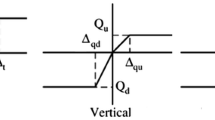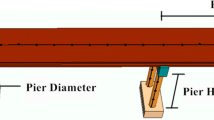Abstract
Ground-motion Intensity Measures (IMs) are used to quantify the strength of ground motions and evaluate the response of structures. IMs act as a link between seismic demand and seismic hazard analysis and therefore, have a key role in performance-based earthquake engineering. Many studies have been carried out on the determination of suitable IMs in terms of efficiency, sufficiency and scaling robustness. The majority of these investigations focused on ordinary structures such as buildings and bridges, and only a few were about buried pipelines. In the current study, the optimal IMs for predicting the seismic demand of continuous buried steel pipelines under near-field pulse-like ground motion records is investigated. Incremental dynamic analysis is performed using twenty ground motion records. Using the results of the regression analysis, the optimality of 23 potential IMs are studied. It is concluded that specific energy density (SED) followed by \(\sqrt {VSI[{\omega _1}(PGD + RM{S_d})]} \) are the optimal IMs based on efficiency, sufficiency and scaling robustness for seismic response evaluation of buried pipelines under near-field ground motions.
Similar content being viewed by others
References
Alfredo HS and Wilson H (1975), Probability Concepts in Engineering Planning and Design, John Wily and Sons, New York.
American Lifelines Alliance (2001), Guidelines for the Design of Buried Steel Pipe, American Society of Civil Engineers.
Baker JW and Cornell CA (2005) “A vector-valued ground motion intensity measure consisting of spectral acceleration and epsilon,” Earthquake Engineering & Structural Dynamics, 34(10): 1193–1217.
Bianchini M, Diotallevi P and Baker J (2009), “Prediction of Inelastic Structural Response Using an Average of Spectral Accelerations,” Proceedings of the 10th International Conference on Structural Safety and Reliability, ICOSSAR09, Osaka, Japan, pp. 13–17.
Bradley BA, Cubrinovski M, Dhakal RP and MacRae GA (2009), “Intensity Measures for the Seismic Response of Pile Foundations,” Soil Dynamics and Earthquake Engineering, 29(6): 1046–1058.
Bruneau M, Uang CM and Sabelli SR (2011), Ductile Design of Steel Structures, McGraw Hill Professional, New York.
Cornell CA, Jalayer F, Hamburger RO and Foutch DA (2002), “Probabilistic Basis for 2000 SAC Federal Emergency Management Agency Steel Moment Frame Guidelines,” Journal of Structural Engineering, 128(4): 526–533.
Davis C and Bardet J (1998), “Seismic Analysis of Large-Diameter Flexible Underground Pipes,” Journal of Geotechnical and Geoenvironmental Engineering, 124(10): 1005–1015.
De Biasio M, Grange S, Dufour F, Allain F and Petre-Lazar I (2014), “A Simple and Efficient Intensity Measure to Account for Nonlinear Structural Behavior,” Earthquake Spectra, 30(4): 1403–1426.
Hindy A and Novak M (1979), “Earthquake Response of Underground Pipelines,” Earthquake Engineering & Structural Dynamics, 7(5): 45–476.
Liu A-w, Hu Y-x, Zhao F-x, Li X-j, Takada S and Zhao L (2004), “An Equivalent-Boundary Method for the Shell Analysis of Buried Pipelines under Fault Movement,” Acta Seismologica Sinica, 17: 150–156.
Luco N (2002), “Probabilistic seismic demand analysis, SMRF connection fractures, and near-sourceeffects,” Ph.D. Thesis, Stanford University.
Luco N and Cornell CA (2007), “Structure-Specific Scalar Intensity Measures for Near-Source and Ordinary Earthquake Ground Motions,” Earthquake Spectra, 23(2): 357–392.
Mackie K and Stojadinovic B (2005), “Fragility Basis for California Highway Overpass Bridge Seismic Decision Making,” PEER Report 2005/12, University of California, Berkeley, CA.
Mazzoni S, McKenna F, Scott MH and Fenves GL (2006), OpenSees command language manual, Pacific Earthquake Engineering Research (PEER) Center, University of California, Berkeley, CA.
Mehanny SS (2009), “A Broad-Range Power-Law form Scalar-Based Seismic Intensity Measure,” Engineering Structures, 31(7): 1354–1368.
Mollaioli F, Lucchini A, Cheng Y and Monti G (2013), “Intensity Measures for the Seismic Response Prediction of Base-Isolated Buildings,” Bulletin of Earthquake Engineering, 11(5): 1841–1866.
OpenSees Wiki (2016), “RambergOsgoodSteel Material,” https://doi.org/opensees.berkeley.edu/wiki/index.php/RambergOsgoodSteel_Material.
Padgett JE and DesRoches R (2008), “Methodology for the Development of Analytical Fragility Curves for Retrofitted Bridges,” Earthquake Engineering & Structural Dynamics, 37(8): 1157–1174.
PEER Ground Motion Database (2016), https://doi.org/peer.berkeley.edu/products/strong_ground_motion_db.html.
Riddell R (2007), “On Ground Motion Intensity Indices,” Earthquake Spectra, 23(1): 147–173.
Saberi M, Halabian AM and Vafaian M (2011) “Numerical analysis of buried steel pipelines under earthquake excitations,” In: Pan-Am CGS Geotechnical Conference.
Saberi M, Behnamfar F and Vafaeian M (2013) “A Semi-Analytical Model for Estimating Seismic Behaviour of Buried Steel Pipes at Bend Point under Propagating Waves,” Bulletin of Earthquake Engineering, 1(3): 1373–1402.
Shakib H and Jahangiri V (2016), “Intensity Measures for the Assessment of the Seismic Response of Buried Steel Pipelines,” Bulletin of Earthquake Engineering, 14(4): 1265–1284.
Shome N and Cornell CA (1999), “Probabilistic Seismic Demand Analysis of Nonlinear Structures,” (Report No. RMS35), PhD Thesis, Stanford University, California.
Shome N, Cornell CA, Bazzurro P and Carballo JE (1998), “Earthquakes, Records, and Nonlinear Responses,” Earthquake Spectra, 14(3): 469–500.
Tothong P and Luco N (2007), “Probabilistic Seismic Demand Analysis Using Advanced Ground Motion Intensity Measures,” Earthquake Engineering & Structural Dynamics, 36(13): 1837–1860.
Vamvatsikos D and Cornell CA (2005), “Developing Efficient Scalar and Vector Intensity Measures for IDA Capacity Estimation by Incorporating Elastic Spectral Shape Information,” Earthquake Engineering & Structural Dynamics, 34(13): 1573–1600.
Author information
Authors and Affiliations
Corresponding author
Rights and permissions
About this article
Cite this article
Kiani, A., Torabi, M. & Mirhosseini, S.M. Intensity measures for the seismic response evaluation of buried steel pipelines under near-field pulse-like ground motions. Earthq. Eng. Eng. Vib. 18, 917–931 (2019). https://doi.org/10.1007/s11803-019-0543-4
Received:
Accepted:
Published:
Issue Date:
DOI: https://doi.org/10.1007/s11803-019-0543-4




